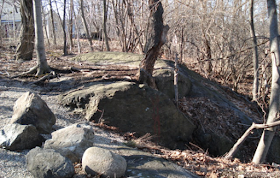Via altereddimensions.net
The location where the Salem witches were executed (by hanging) has long been suspected but never precisely defined nor proven . In general, it was known that most of the twenty-five people accused of witchcraft in the Salem Witch Trials, were hung on Gallows Hill, an area which comprises many acres of land (today with residential houses scattered throughout). Although most people felt the location of the hangings was the summit of the hill, in 1936, historian Sidney Perley proposed the precise location was Proctor’s Ledge, a rocky ledge near the base of Gallows Hill. Until now however, most still felt, and tradition held, that the exact location was somewhere atop the hill.
Although there are about 1,000 official records detailing the Salem witch trials, scant evident about the actual executions exists leaving researchers little means to determine the precise location where the accused witches met their end (the trials were an embarrassment and source of shame to Salem and the community tried hard to forget the event). This changed after a group of seven scholars formed the Gallows Hill Project and set out in 2010 to answer the question once and for all.
One piece of evidence came from a letter written in 1791 by “Dr. Holyoke”. The letter described a story told by a man who was born the year the hangings occurred (1692).
“In the last month, there died a man in this town by the name of John Symonds, aged a hundred years lacking about six months, having been born in the famous ’92. He has told me that his nurse had often told him, that while she was attending his mother at the time she lay in with him, she saw, from the chamber windows, those unhappy people hanging on Gallows Hill, who were executed for witches by the delusion of the times.”
Using the description from the letter, it was found that it was impossible to see the summit of Gallows Hill from the home that Symonds was born in. However, a nearer, lower hill – Proctor’s Ledge, was well within view.
The scholars dug up additional evidence. They knew that the eight victims hanged on September 22 were driven by cart to the execution site. It would have been nearly impossible to get a cart full of eight victims up a steep and rocky slope that led to the summit of Gallows Hill (there was no road). Additionally, it was known that in 1747, locust trees had been planted in the area of the hangings as a form of tribute to the victims. According to President John Adams, who visited “Witchcraft Hill” in 1766,
“Somebody within a few years has planted a number of locust trees over the graves, as a memorial.”
Investigators queried the owner of land that butted against Proctor’s Ledge and asked if locust trees had ever grown there. Indeed they had, although they had recently been cut down.
The concluding piece of evidence was found in an eyewitness account dated August, 19, 1692. The witness, accused witch Rebecca Eames, travelled to court that day along Boston Road. During her interview, she was asked if she had passed an execution that morning (five executions had taken place earlier that day). She answered that she saw some “folks” there while at the “house below the hill” (her guards left her briefly in the home while they stepped outside to watch the hangings). Luckily for researchers, there were few homes on Boston Street and scholars were able to identify the home that Eames saw the hangings from as the “McCarter” residence at 19 Boston Street. A “view-shed analysis” revealed that it was not possible to see the top of Gallows Hill from the home’s location. Proctor’s Ledge however, was in plain sight.
At the time of the hangings, Proctor’s Ledge was public land where residents could graze sheep. It is named for Thorndike Proctor, who purchased the land during the 18th century (ironically, he is a descendant of a witch trial victim, John Proctor). Given that executions then were meant “to serve as an example of what happens to people who break the law,” the highly visible site on Proctor’s Ledge was a logical choice.
Tom Brophy, 72, lives in front of Proctor’s Ledge. He told reporters he was not surprised by recent conclusion.
“The old timers that used to be here when I was a little kid used to talk about the witchcraft and that this was the probable site.”
Today the city-owned Proctor’s Ledge, which lies between Proctor and Pope streets, is a wooded area that overlooks a Walgreens store. The city plans to mark the location with a “modest” memorial.
Additional information
The Witch Tree
Interestingly, on the site was a “Witch Tree” that grew there as late as 1793. The tree was rather odd. It divided a foot or two above the ground into two trunks that then grew wildly apart, only to reunite into a single trunk several feet higher. According to one researcher, after the Salem Witch hysteria, “it was the custom among some Salem residents to pass new-born babies through the hole to protect them from witches.”
Want to take the same path to Proctor’s Ledge that the witches took?
According to researcher Daniel Boudillion:
“The known route from Salem to the hanging site is from Prison Lane (now St. Peter Street), then the long ride down Essex Street, thence a short ride on Bridge Street (now Boston Street), and over Town Bridge and then left to the hill."
Source


No comments:
Post a Comment